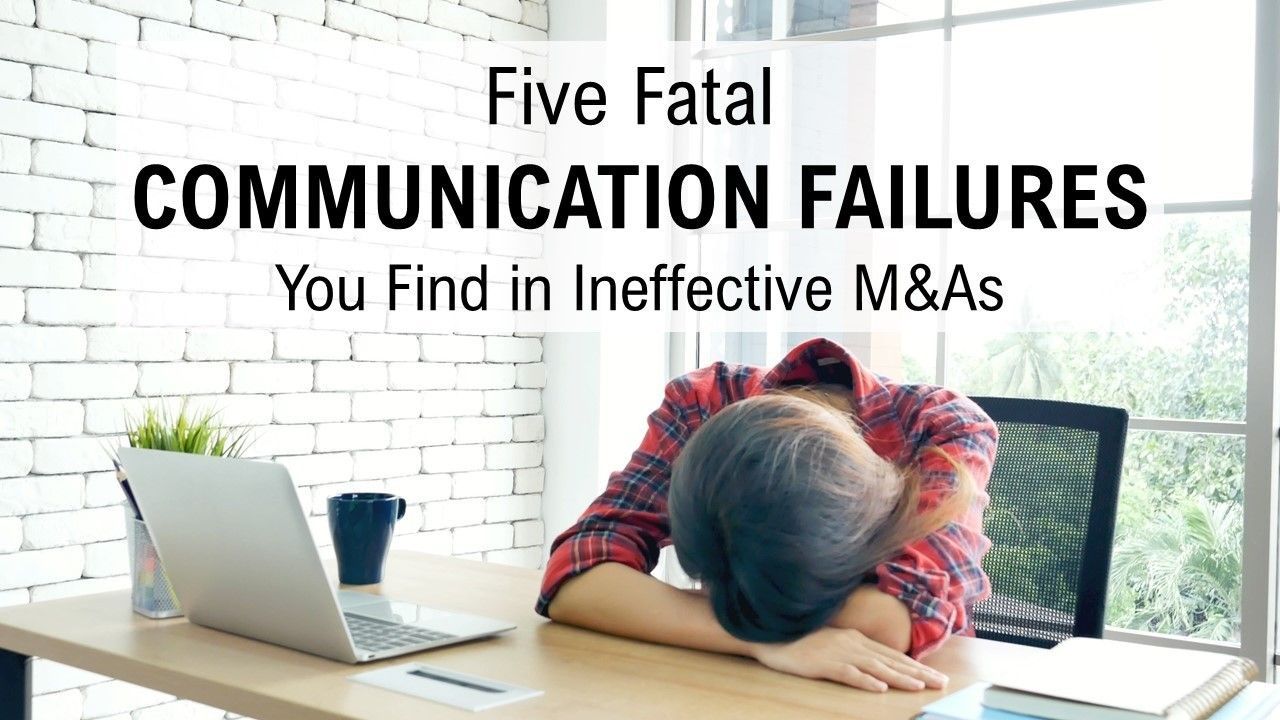THE RISK : what is lost forever
“Good News! No one is being laid off”
Hearing this when your company is acquired can be the best six words you ever hear as an employee. But what happens when things change? Once leadership has time to truly evaluate and this statement is no longer true?

Transparency can be a double-edged sword
Transparency is an important ingredient for building #trust and creating a high-performing company culture that attracts top talent. Sharing information about company performance helps people feel valued and enables them to understand the reasoning behind decisions being made by leadership.
Stepping up to communicate life-changing news to your employees like a pending layoff can be as difficult as making the decision in the first place, especially if you are a caring leader of a company with a good culture. Knowing you are going to lay off good people is a difficult burden to carry, and your instinct may be to rip the band aid off and come clean about what you expect may be coming – even before you have all the facts at your disposal. But in the face of shocking news, people want certainty, so they know how to proceed. If you do not have all the answers, this may be one of those times where too deep a commitment to transparency can work against you and destroy morale.
When transparency backfires, trust may be lost forever.
A while back, I was brought in to help a local manufacturer that had recently acquired a smaller business that made and imported complimentary products to their original product lines. During our intake discussions, I learned that staff across both organizations were exhausted from the demands of keeping production on track while integrating two sets of business platforms and processes, coupled with the stress and uncertainty of working with new leaders and team members, no longer knowing who to go to for answers to their business process questions, and not having clarity and security in their new roles.
From a messaging standpoint, the newly combined leadership team had initially assured people at the acquired company that everyone was needed from both organizations, and that there was no need for anyone to be concerned about their jobs…each company manufactured something distinctly different, and there was very little production redundancy resulting from the acquisition. Unfortunately, despite this intention, several months after the companies began integrating, and well before the process was complete, the private equity investors and board of directors began asking tough questions about cost containment – and before the leaders knew it, they were being asked to conduct a workforce reduction.
Surprised by the board and investors’ expectations, the leadership team was misaligned around how best to communicate this turn of events. One of the leaders, in the spirit of “full transparency” – announced that there were to be layoffs early the next year. Knowing where they were in the integration process, IT and operations leaders and their human resource partners knew they would not be able to share meaningful information about the size of the workforce reduction for several months until a significant percentage of the systems integration work could be completed. The resulting 5-month silence left the full 3,800 person staff from both companies living with heightened uncertainty on top of their overwork and growing burnout from the changes they participated in, each convinced that the cuts would be deep and that they would be among the casualties. Morale sank so low that leaders had to offer retention bonuses to key staff to ensure that those needed to complete the transition would not leave prematurely and harm the integration timeline.
The people from both organizations felt betrayed because their leaders had assured them that the acquisition had been about extending the breadth of the product line and adding new product categories, not gaining personnel efficiency. Workers who had been asked to come together as newly formed teams looked at each other with suspicion, wondering which of them would survive the impending layoffs. And although the initial communication about layoffs was made in the name of transparency, the lack of timely follow-up further eroded trust. The employees were convinced that leadership simply did not care about the discomfort they were experiencing with a proverbial axe hanging over their heads.
What disengagement drivers were in play in this troubling scenario?
I began working with company leaders shortly after the layoff took place. Anecdotal feedback I received from speaking with the more vocal of the remaining staff was validated by the dismal feedback received through an initial engagement survey (which received an exceptionally low response rates – a classic byproduct of low trust and disengagement).
Remaining employees from both companies at all levels indicated experiencing:
- A Lack of Trust, and Transparent Communications: The employees were unable to overcome their mistrust in messaging from senior leadership who had started their acquisition with promises of no workforce reductions.
- Low Faith in Future Career Growth Opportunities: While some people did received advancements because of the workforce reduction, they felt that they had profited on the backs of their friends and colleagues; people no longer had faith that the company was flourishing and would be able to offer them a promising career.
- Chronic Overwork and Burnout; Lack of Recognition and Support: The staff already felt burned out from the prolonged effort to keep manufacturing production levels steady without a hitch while undergoing new systems and business process integrations. Now they would be carrying the company’s production load forward with fewer colleagues.
- Lack of Autonomy and Empowerment: Having life altering changes thrust upon them without their having any say undermined the sense of autonomy, empowerment, and control at all levels.
- Poor or Uninspiring Organizational Culture:
The company culture – already unclear and destabilized because two companies were in the process of merging together – seemed fractured and to many, beyond redemption.
Stepping in to assist leaders in the aftermath of the layoffs, I helped them develop a communications plan to regain the lost faith in leadership and reestablish a positive high-performance culture for the now-integrated organization. It took a year to develop and execute a plan to regain trust, enthusiasm, and psychological safety -- and to get people working better together as a strong, cohesive team that was meeting and exceeding performance targets.
There isn't a simple "undo" button in business, and the deep work this organization did to right the ship wasn't easy. While leadership had done what they thought was best by being transparent, they now realized that even transparency should be used strategically, with the goal always being to build and maintain their people’s trust. Because reengaging their people was important to the leadership team and they worked hard to align around a meaningful message strategy and commit to a cadence for communicating and connecting with their people going forward.
We all get it – sometimes we must make incredibly tough decisions to keep our businesses on track to even have a future. But it is also important to remember that your people are human beings – they have hopes and fears and career aspirations and insecurities – and families and mortgages and college tuition to pay for just like you. Sometimes when you lose the faith of your best people you never do get a chance to win it back. That is why it is so important to learn how to be thoughtful and caring with the degree of transparency you put into your communications.
I believe we all benefit in our business journeys by sharing stories of overcoming hard things.
What is something you can take back to your own organization to make strategic use of transparent communications in your business?









